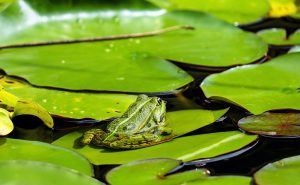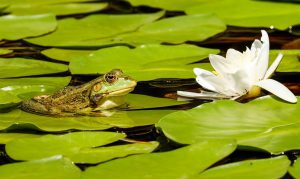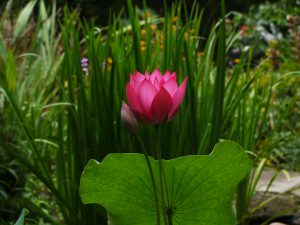Friday
Featured StoriesBeauty and Balance
A goldfish pond creates a haven for nature, and also builds friendship and community
by David Zurick
 The frogs discovered my goldfish pond on the first day I filled it with water. The pond hadn’t yet settled into the garden. Its rubber liner showed like an embarrassing exposure, spilling out of its hole and onto the bare ground, and the rocks on the bottom glistened like the glossy stones of an empty, store-front aquarium. The pond looked like it had just been off-loaded from a delivery truck. Still, the frogs must have liked it when they came upon it because some of them stayed and made the pond their home.
The frogs discovered my goldfish pond on the first day I filled it with water. The pond hadn’t yet settled into the garden. Its rubber liner showed like an embarrassing exposure, spilling out of its hole and onto the bare ground, and the rocks on the bottom glistened like the glossy stones of an empty, store-front aquarium. The pond looked like it had just been off-loaded from a delivery truck. Still, the frogs must have liked it when they came upon it because some of them stayed and made the pond their home.
I recall it being a dry season, so maybe the frogs had been lying in wait all along, patiently watching me work and wondering when I might finish, and then just hopped in once I had provisioned the hole with water. Or perhaps they were passing by on their way to another destination, sensed its deliquescence, and got distracted. I’ll never know for certain what those pioneer frogs were thinking when they came upon my goldfish pond. They were its first settlers.
Over time, I put plants into the ground around the pond – evergreens and shrubs like japonica, holly, and rhododendron, and set aquatic plants in pots – water lilies, pickerel, and a hardy lotus. I installed a filtration system with an aerating concrete fountain in the likeness of a Hindu deity. A rock terrace below the pond was filled with flowering bushes, perennials, and an assortment of annual blossoms that attract bees and butterflies in great numbers. Nearby, we planted magnolia, American holly, and native dogwood trees. In this way, slowly over time and plant-by-plant, we transformed the rubber-lined pond into an aquatic garden.
 I began meeting my neighbor George in the morning for coffee at my goldfish pond in the simple notion that such moments might be pleasurable for us and provide us with a chance to disengage for a short while from societal forces that seemingly lie beyond our control. We sit on a wooden bench beneath a magnolia tree and watch the pond spring to life. The fish always appear agitated at our arrival – not frightened, just anxious to be fed. The frogs, meanwhile, peer at us like Zen monks from their solitary perches around the pond, dispassionate and unblinking. Scattered here and there amid the pads of greenery are the pure-white lily flowers.
I began meeting my neighbor George in the morning for coffee at my goldfish pond in the simple notion that such moments might be pleasurable for us and provide us with a chance to disengage for a short while from societal forces that seemingly lie beyond our control. We sit on a wooden bench beneath a magnolia tree and watch the pond spring to life. The fish always appear agitated at our arrival – not frightened, just anxious to be fed. The frogs, meanwhile, peer at us like Zen monks from their solitary perches around the pond, dispassionate and unblinking. Scattered here and there amid the pads of greenery are the pure-white lily flowers.
 George and I sometimes use the efflorescence of a water lily as a sort of timepiece to gauge the length of our stay at the pond. It takes about an hour for one to fully unfold once the sun settles upon a blossom, which also is the time required for me to watch a sunset at the end of a day – not just the flaming orb sinking into the horizon but to witness the whole glorious alchemy of refracted colors transmuting in the crucible of the evening sky. This is to say, from a certain perspective, the speed of a lily blossom unfolding in a goldfish pond is synchronous with the spin of the earth on its axis.
George and I sometimes use the efflorescence of a water lily as a sort of timepiece to gauge the length of our stay at the pond. It takes about an hour for one to fully unfold once the sun settles upon a blossom, which also is the time required for me to watch a sunset at the end of a day – not just the flaming orb sinking into the horizon but to witness the whole glorious alchemy of refracted colors transmuting in the crucible of the evening sky. This is to say, from a certain perspective, the speed of a lily blossom unfolding in a goldfish pond is synchronous with the spin of the earth on its axis.
The pond becomes hyper-animated once the morning air sufficiently warms. Dragonflies swoop in tight formations before the pollen promise of aquatic plants; they suddenly stop and hover like trapeze artists while inspecting the nourishing anther of a flower. Ruby-throated hummingbirds dart in loud and nervous blurs, switching directions on a dime, balancing as delicate, spinning iridescent baubles on a point-of-air. Fat carpenter bees in yellow-and-black uniforms float above the pond like the Goodyear Blimp on Super Bowl Sunday. All the while, frogs leap from the lily pads to the rocks and fish swim through the clear water. At the height of action, the goldfish pond becomes thick with the ecosystem antics of Kingdom Animalia: it’s a regular Barnum-and-Bailey Circus once the sun settles onto the pond’s surface.
 It’s now customary for George and me to sit by my goldfish pond on nice mornings when we have the chance. Such meetings help to hold our worlds together and have become a small part of the pattern of our lives. We quietly observe the pond’s natural elements, understanding that we are more than audience, and bear witness to how beauty and balance is all around for us to see. This realization, in turn, asks me to consider how best to conduct myself amid the global trends that shape our planet, to live a thoughtful life, however modest and constrained, and to be at least cognizant of natural forces while living moment by moment and in kind consideration of others. Like a mirror set into the glebe of Earth, my little goldfish pond stares back at me with all the force of the Universe, and prods me to consider once again my proper place in the world.
It’s now customary for George and me to sit by my goldfish pond on nice mornings when we have the chance. Such meetings help to hold our worlds together and have become a small part of the pattern of our lives. We quietly observe the pond’s natural elements, understanding that we are more than audience, and bear witness to how beauty and balance is all around for us to see. This realization, in turn, asks me to consider how best to conduct myself amid the global trends that shape our planet, to live a thoughtful life, however modest and constrained, and to be at least cognizant of natural forces while living moment by moment and in kind consideration of others. Like a mirror set into the glebe of Earth, my little goldfish pond stares back at me with all the force of the Universe, and prods me to consider once again my proper place in the world.
 David Zurick travels often from his Wolf Gap home to photograph and write about distant places. He is the author of numerous award-winning books and maintains a photo blog called “Picture Pilgrims.” You can find out more at: www.davidzurick.com.
David Zurick travels often from his Wolf Gap home to photograph and write about distant places. He is the author of numerous award-winning books and maintains a photo blog called “Picture Pilgrims.” You can find out more at: www.davidzurick.com.
Editor’s note: this piece is an excerpt from David’s latest book, Morning Coffee at the Goldfish Pond: Seeing a World in the Garden. A trailer for his book is available on YouTube: https://www.youtube.com/watch?v=CIm50ohlcs0
















